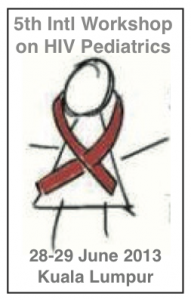Vertical transmission continues to decline in UK and Ireland
25 July 2013. Related: Conference reports, Pregnancy, Paediatric Workshop 5 Kuala Lumpur 2013.

Polly Clayden, HIV i-Base
The rate of vertical transmission of HIV continued to inch its way down further between 2007 and 2011 than in previous years, according to data presented at the 5th International Workshop on HIV Pediatrics.
Claire Thorne from the Centre of Epidemiology for Child Health, UCL Institute of Child Health, London presented findings from the National Study of HIV in Pregnancy and Childhood (NSHPC) – a population-based surveillance study. In the UK and Ireland children born to HIV-positive mothers are followed up to establish their own HIV status. Dr Thorne presented analyses including live singleton births born 2000 to 2011 and reported to the NSHPC by March 2013.
In 2000 to 2006, the vertical transmission rate in diagnosed women in the UK and Ireland was already very low at 1.2%. The investigators compared this previous rate to that from 2007 to 2011 and looked at different treatment and mode of delivery scenarios. They examined the association between ART with three or more antiretrovirals and the probability of transmission using generalised additive models.
There were 12,487 singleton live births to HIV positive women between 2000 and 2011. Of 6377 births in 2007 to 2011, 72% were to women diagnosed prior to becoming pregnant compared to 46% in 2000 to 2006, p<0.001.
The majority of women (96%) received ART in pregnancy in 2007 to 2011 compared to 82% in the earlier time period; of these 41% started treatment before conception, compared to 25% in 2000 to 2006, both comparisons p<0.001.
There was an increase in the proportion of women with an undetectable viral load closest to delivery (median 23 days, IQR 9-42), respectively 76% and 57% in the later and earlier periods, p<0.001.
Women started ART significantly earlier in 2007 to 2011 at a median 22.7 weeks gestation than in 2000 to 2006 at a median 25.7 weeks, and twice as many had planned vaginal deliveries, 31% compared to 14%, both comparisons p<0.001.
The overall vertical transmission rate in 2007 to 2011 was 0.57% (33/5788; 95% CI 0.42-0.84%), which was significantly lower than in 2000 to 2006, p<0.001. Incomplete data from 2010 to 2011 shows the rate reached 0.46% during the most recent year examined.
Excluding breast fed infants and/or those with clear evidence of post natal transmission, the proportion attributable to short duration of ART or lack of treatment has declined from 77% to 24% in the earlier and later time periods respectively, p<0.001.
Transmission rates in 2007 to 2011 in women on ART were: 0.2% (3/1720) in those with planned vaginal delivery, 0.6% (12/2050) with elective caesarean section and 0.5 (7/1360) with emergency caesarean section. Intrapartum/postpartum transmission rates were: 0.05% (2/3915) in women with viral load <50 copies/mL at a median of 23 days before delivery, 1.0% (97/684) in those with 51-4000 copies/mL and 2.9% (13/447) in those with >400 copies/mL. The investigators noted that it was improbable that either of the two transmissions, which occurred despite ART or undetectable viral load were in utero transmissions (both infants tested negative at birth).
The probability of vertical transmission among 6507 pregnancies delivered 2000-2011 by duration of ART was modelled, this declined sharply with each additional week of treatment up to about 10 weeks duration, levelling off at 0.4% after about 13 weeks of ART.
Overall, vertical transmission rates in the UK and Ireland continued to improve in recent years, reaching the all time lowest level of 0.46% in 2010, despite an already very successful programme. This was mostly due to a reduction in transmissions associated with starting ART late or receiving no of ART in pregnancy, as well as an increase in the proportion of women on ART at conception.
Reference:
Townsend CL et al. Mother-to-child transmission of HIV continues to decline in the UK and Ireland. 5th International Workshop on HIV Pediatrics. 28 – 29 June 2013, Kuala Lumpur, Malaysia. Late breaker oral abstract. O_09.
http://regist2.virology-education.com/2013/5hivped/docs/16_Thorne.pdf (PDF slides)

